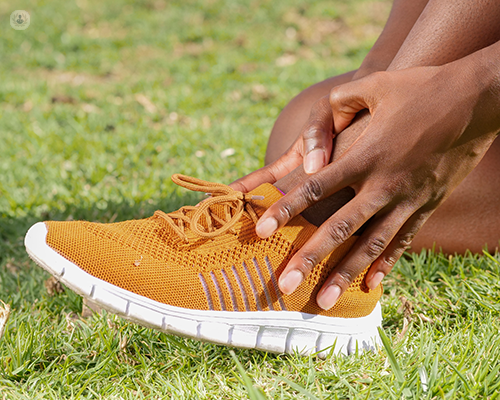Ankle sprains and the risk of chronic instability
Written by:A sprained ankle is a very common injury to one or more ankle ligaments that needs proper treatment to heal – and to do this correctly. Mr Bal Dhinsa, leading consultant orthopaedic surgeon, explains how an ankle sprain affects the condition of an ankle.

How easy is it to sprain one’s ankle?
The ankle joint is stabilised by the soft tissues around it so when the ankle rolls over, these tissues can become stretched, disrupted or completely torn. Around the ankle, the ligaments on the outer or lateral side (anterior talofibular ligament and calcaneo-fibular ligament) are most commonly affected. Less frequently, the deltoid ligaments on the inner or medial side of the ankle can be affected.
Trauma is often the cause, but some patients may have hypermobility as well. Wearing the wrong type of footwear for activity or, walking or running on an uneven surface places unusual stresses on the soft tissues.
How will an ankle sprain be diagnosed or detected?
Typically, patients have pain around the injured area with swelling, which may be associated with instability when walking or running. A thorough examination and appropriate imaging or tests will help with diagnosis.
How will I know if it’s just a sprain and not a broken bone?
This can often be mistaken. You would expect a broken bone to cause more pain, tenderness and swelling, but this is not always the case. A review by an appropriate specialist would be sensible to assess for this.
How are ankle sprains treated most effectively?
Initial management for all ankle sprains without a fracture should include the protection of the joint (ankle brace or walking boot), rest (crutches), compression (sometimes a compression bandage is of help) and elevation. Non-steroidal anti-inflammatory medication and analgesics can also be used. Early functional physiotherapy will be instigated to help with the recovery.
The majority of ankle sprains settle with time following this management, however if it does not, then further investigation with magnetic resonance imaging (MRI) will be done.
With persistent pain and symptoms of instability, surgical intervention can also be considered.
Will my ankle be affected for life after spraining it in any way?
You are at more risk of re-injuring your ankle in the first year after a sprain. If left untreated, it can develop into a chronic instability, which can impact the range of motion as well as potentially damaging the joint surfaces and leading to an arthritic process.
Mr Bal Dhinsa is an accomplished consultant orthopaedic surgeon based in Kent and London who specialises in the treatment of conditions in the foot and ankle. If you’re suffering from an ankle injury and wish to seek expert treatment, make sure to visit Mr Dhinsa’s Top Doctors profile today.


